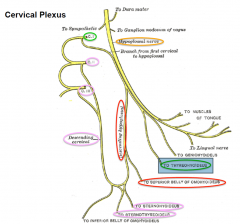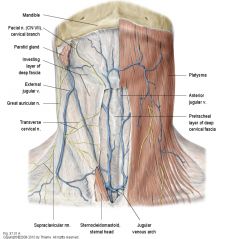![]()
![]()
![]()
Use LEFT and RIGHT arrow keys to navigate between flashcards;
Use UP and DOWN arrow keys to flip the card;
H to show hint;
A reads text to speech;
42 Cards in this Set
- Front
- Back
|
Anterior triangle boundaries
|
superior = inferior, posterior mandible posterior= anterior margin of SCM anterior= midline of neck |
|
|
Subdivisions of anterior triangle
|
2. Submental triangle 3. Submandibular triangle 4. Carotid triangle |
|
|
Hyoid bone
|
2. Attaches to muscle, ligaments 3. Attaches to muscles of tongue and floor of mouth above 4. Attaches to larynx below 5. Attaches to epiglottis and pharynx behind 6. Aids in tongue movement and swallowing, speech |
|
|
Describe cervical plexus/ansa cervicales
|

C1 - hitchhikes w/hypoglossal, becomes superior root of ansa cervicales, supplies superior omohyoid OR keeps going, supplies thyrohyoid, geniohyoid as separate nerves C2 +3 -inferior root of ansa cervicales, supply inferior omohyoid, sternohyoid, sternothyroid |
|
|
Hyoglossus M*
|
Pulls base of tongue down, initiates swallowing so tongue flattens and elevates to throw food over. |
|
|
Carotid triangle components to note
|

1. IJV drains cranial cavity 3. Common carotid bifurcates into external, internal carotid. 4. Vagus nerve (CN10) 5. Carotid body, carotid sinus - baroreceptors control BP, chemoreceptors monitor pH. |
|
|
Carotid body*
|
Contains baro, chemoreceptors. Putting direct pressure here for a tachy pt tricks body into thinking BP too high, so heart rate slows. Otherwise, tachycardia leads to low BP, even faster HR. |
|
|
External carotid - trace pathway
|

|
|
|
Sympathetics in anterior triangle
|
REVIEW 34-37. superior, middle, inferior cervical ganglion |
|
|
Lymph nodes in neck
|
Nodes of neck --- deep cervcical nodes --- jugular trunk --- thoracic duct/right lymph duct |
|
|
3 salivary glands
|
Submandibular : all the time/ On floor of mouth, surrounds mylohyoid muscle (slide 40) Parotid : only produces as needed |
|
|
Neck layers
|
2. Respiratory: Larynx, trachea 3. Alimentary: Pharynx, esophagus |
|
|
Superficial structures to note
|

2. EJV - small superficial vein, used for grafts. Drains superficial structures 3. Superficial nerves: great auricular, transverse cervical. Sensation to superficial structures. 4. Submandibular, parotid glands. 5. Investing layer of deep fascia |
|
|
Muscular triangle borders, components
|
2. Contains Infrahyoid (strap) muscles |
|
|
Sternohyoid M
|
2. Insertion: Hyoid bone 3. Action: Depress larynx as whole 4. Innervation: Ansa cervicales |
|
|
Omohyoid M
|
2. Insertion: Hyoid bone 3. Action: Depress larynx as whole 4. Innervation: Ansa cervicales *Intermediate tendon splits into superior, inferior belly |
|
|
Sternothyroid M |
2. Inserion: oblique line of thyroid cartilage 3. Action: Depressor of larynx as whole 4. Innervation: Ansa cervicales |
|
|
Thyrohyoid M
|
2. Insertion: Hyoid bone 3. Innervation: C1 traveling with hypoglossal (12) part of ansa cervicales 4. Action: elevates larynx as whole |
|
|
Carotid triangle borders, components
|
1. Borders: Anterior SCM, Superior omohyoid, inferior belly digastric 2. Components: Bifurcation of common carotid |
|
|
Carotid sheath, carotid artery
|
2. Carotid arery splits into internal, external carotid at upper border of thyroid cartilage 3. Internal carotid has no branches In neck |
|
|
External carotid artery branches (name inferior to superior branches)
|
1. Superior thyroid + Superior laryngeal branch, which travels with internal branch of superior laryngeal nerve through thyrohyoid membrane. 2. Lingual artery - passes deep into hyoglossus muscle 3. Facial artery - glandular, submental, tonsilar/ascending palatine branches 4. Ascending pharyngeal - posterior external carotid to wall of pharynx 5. Occipital artery - posterior external carotid, hooks over hypoglossal nerve towards mastoid process. Travels with greater occipital nerve. 6. A) Maxillary or B) Superficial temporal artery *note: lingual artery may come off facial in variations |
|
|
Submental triangle borders
|
1. 2 anterior digastric muscle bellies and hyoid bone 2. Only unpaired triangle. Contains median raphe of mylohyoid muscle |
|
|
Digastric/submandibular triangle borders and contents
|
2. Suprahyoid muscles - act on jaw, mouth, and tongue, innervated by cranial nerves 3. Submandibular gland 4. Submandibular lymph nodes 5. Vessels: Facial artery, facial vein |
|
|
Digastric muscle
|
2. Intermediate tendon - pulley attached to hyoid bone 3. Insertion: Anterior belly ascends, inserts onto inner mandible (midline) 4. Innervation: Posterior = CN7, Anterior = CN5 5. Action: Elevator of larynx |
|
|
Stylohyoid
|
2. Insertion: Hyoid bone 3. Splits and passes around tendon of digastric muscle 4. Innervation: CN7 5. Action: elevates larynx |
|
|
Mylohyoid
|
2. Origin: Mylohyoid line of mandible 3. Insertion: hyoid bone and connective tissue raphe that extends from hyoid to mandible in midline 4. Innervation: CN5 5. Action: Elevates larynx |
|
|
Geniohyoid
|
1. Above mylohyoid, inside mouth 2. Origin: Inferior genial tubercle of mandible 3. Insertion: Body of hyoid bone 4. Innervation: C1, C2 through hypoglossal nerve 5. Action:??? |
|
|
Submandibular gland
|
1. Major salivary gland 2. Almost fills submandibular/digastric triangle 3. Lies below, in front of angle of mandible 4. Divided in large superficial (to mylohyoid), deep small (between mylohyoid, hyoglossus) part of gland 5. Submandibular duct opens at sublingual papilla |
|
|
Vessels in submandibular/digastric triangle
|
A) Submental artery comes off facial 2. Facial vein: Passes over gland in subcutaneous tissue. Lies behind facial artery. |
|
|
Relationships in submandibular/submental triangle*
|
2. Intermediate tendon of digastric on surface of hyoglossus muscle, above hyoid bone 3. Hypoglossal nerve (CN12) runs forward on hyoglossus muscle deep to submandibular gland, passes between mylohyoid/hyoglossus muscles 4. Lingual nerve: btwn mylohyoid and hyoglossus 5. Lingual artery: deep to hyoglossus muscle |
|
|
Superficial venous drainage
|
2. Retromandibular vein 3. Facial vein 4. External jugular vein = posterior auricular + posterior branch of retromandibular. Descends across SCM, empties into subclavian vein. 5. Common facial vein = anterior branch of retromandibular vein + facial vein. Empties into deep structures of neck. |
|
|
Retromandibular vein
|
A) Anterior branch - maxillary vein B) Posterior branch - superficial temporal vein 2. Posterior to ramus of mandible 3. In parotid gland, lateral to external carotid artery |
|
|
Facial vein
|
2. NO VALVES - easy for bacteria 3. Uses deep facial vein as bridge to pterygoid plexus |
|
|
External jugular
|
2. External jugular dumps ----subclavian vein |
|
|
Common facial vein
|
2. Common facial vein dumps -----internal jugular |
|
|
Venous draining of deep structures
|
1. In carotid sheath w/ carotid artery, vagus nerve 2. From dural sinuses within cranial cavity 3. Moves posterior to lateral as it decends (in relation to internal carotid artery) |
|
|
Lymph drainage
|
??? REVIEW!!! |
|
|
Cranial nerves*
|
2. Facial (7) - Stylohyoid and posterior belly of digastric. Cervical branch supplies platysma. 3. Glossopharyngeal (9) - carotid sinus 4. Vagus: * REVIEW A Superior/inferior cervical cardiac nerves (visceral branches to cardiac plexus) B. Superior laryngeal nerve C. Pharyngeal branch D. Recurrent (inferior) laryngeal nerve 5. Accessory nerve (11): SCM and trapezius 6. Hypoglossal (CN12) |
|
|
hypoglossal nerve
|
2. Deep to mylohyoid muscle 3. Carries branches to ansa cervicalis, thyrohyoid and geniohyoid muscles (actually from C1/C2. just hitchhiking) *review ansa cervicales slide* |
|
|
Cervical portion of sympathetic system - REVIEW
|
A. Internal carotid nerve/plexus B. Superior cervical cardiac nerve C. Pharyngeal branches 2. Middle cervical ganglion ---middle cervical cardiac nerve. C5,6. 3. Inferior cervical ganglion --inferior cervical cardiac nerve. C7,8. 4. Vertebral ganglion - may not be present. |
|
|
Thyroid gland
|
1. Two lateral lobes 2. Median lob, isthmus connects two lateral lobes 3. Pyramidal lobe may be present, extending up from isthmus 4. Blood from superior thyroid artery - branch of external carotid AND inferior thyroid artery - branch of thyrocervical trunk, off subclavian * Endocrine gland - Makes thyroxin, thrycalcitonin - metabolism regulation 5. Drained by Superior, middle, inferior thyroid veins |
|
|
Parathyroid glands
|
2. Superior parathyroid, inferior parathyroid 3. Close relation with recurrent laryngeal nerves on each as nerves travel posterior to thyroid gland (important clinically) 4. Makes parathyroid hormone, regulates calcium levels in blood |

